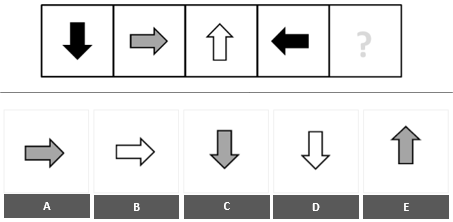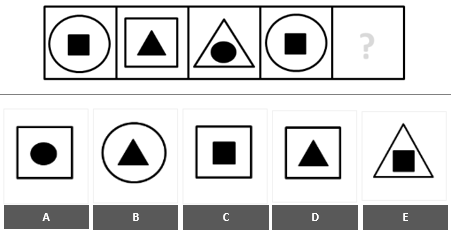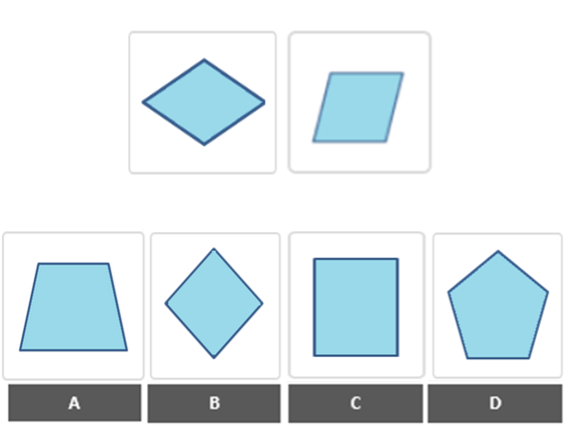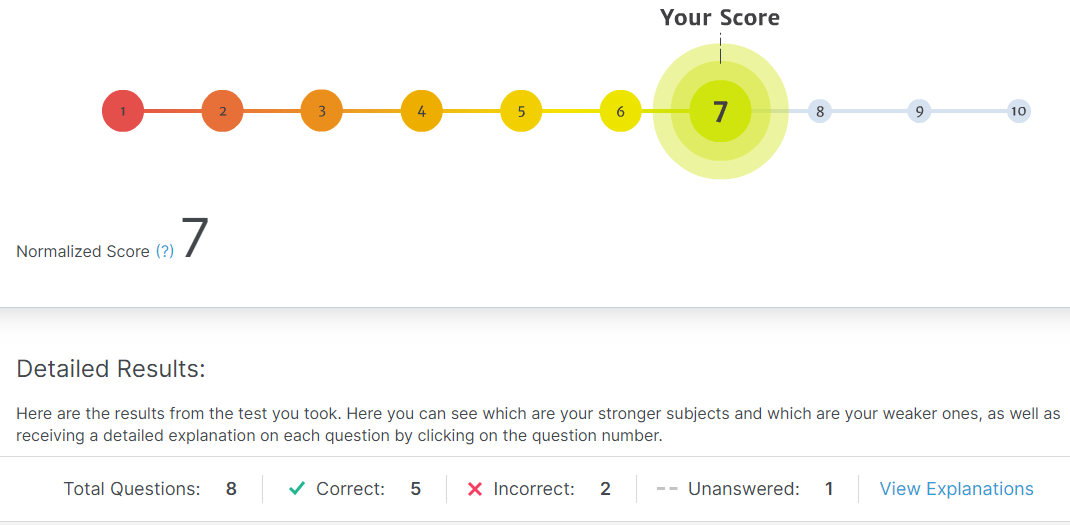 Free PI Cognitive Assessment Practice Test Questions [2025]
Free PI Cognitive Assessment Practice Test Questions [2025]
Last updated: March 10th, 2025
The Predictive Index or PI Cognitive Assessment is a challenging 12-minute cognitive test in which you will need to answer 50 questions that examine your verbal, numerical, logical, and abstract reasoning capabilities.
The exams are difficult because of two challenges: the complex questions and the tight time limit, which leaves you with only 14 seconds per question on average.
The PI test is used by employers all around the world to assess your ability to make decisions, learn, and adapt to different roles and situations.
Two for one: PI Behavioral & Cognitive Bundle PrepPack
Learn more about the PI Behavioral Assessment
💡The PI Cognitive Assessment has many names: Predictive Index Cognitive Assessment, 12-Minute Cognitive Test, PI Cognitive Test, and the Predictive Index (PI) Cognitive Assessment. This page provides preparation for all of them.
PI Cognitive Assessment 50 Questions 12 Minutes
Navigate Our PI Practice Sections With Ease!
To get a better sense of what type of questions you'll encounter on the PI Cognitive assessment, take this interactive text.
Also, see our PDF for free PI Cognitive assessment questions and answers.
Official sources: Timed test.
PI Cognitive Assessment Practice Questions
The PI Cognitive Assessment is a multiple-choice 50-question 12-minute test, covering three cognitive ability categories: verbal, numerical, and abstract reasoning, along with nine subcategories. It primarily evaluates how quickly you can learn and improve your skills.

Important Things to Know:
The Predictive Index Cognitive Assessment is a pre-employment test, developed and administered by Predictive Index, that evaluates a candidate's cognitive abilities, particularly their potential to learn new information. Administered in 12 minutes (with 50 questions, averaging 15 seconds each), it's part of a broader assessment process that also includes the PI Behavioral Assessment based on 17 Personality Types to provide a more holistic view of a candidate's suitability for a role.
The PI Cognitive Assessment is comprised of 3 main topics placed in random order throughout the test:
- Numerical Reasoning: These questions measure your ability to work with numbers, analyze data, and interpret mathematical information. The test often includes around 15 to 20 questions of this type.
- Verbal Reasoning: These questions evaluate your language skills, particularly your ability to understand written text, make logical deductions, and assess the implications of statements. Expect around 15 to 20 questions under this category.
- Abstract Reasoning: These questions assess your ability to identify patterns, make connections, and deduce relationships among various elements. This portion typically consists of 10 to 15 questions.
Typically, you will not receive the answers after completing the Predictive Index (PI) Cognitive Assessment. The results are usually provided to the hiring company or organiזation that administered the test.
Each organization may handle the results of the Predictive Index (PI) Cognitive Assessment differently. If you're curious about whether you'll receive feedback or answers after the test, it's a good idea to ask the company or recruiter administering the test. They can clarify their process for sharing results.
To effectively evaluate which preparation is best for the PI Cognitive Test, consider the following criteria:
- Time Limit: Ensure the preparation allows you to practice under time constraints to improve time management skills.
- Accurate Test-like Questions: Choose materials that provide questions similar to those on the actual test to ensure you're preparing with relevant content.
- Test Conditions: Opt for preparation resources that simulate the test environment, helping you build focus and test-taking stamina.
- Variety of Preparation Materials: Select a mix of study materials to cover all areas of the test, including verbal, numerical, and abstract reasoning.
The JobTestPrep preparation offers you all of the above by providing a comprehensive and structured approach to PI Cognitive Test preparation.
The PI Cognitive Assessment is hard due to the strict time limit, even though the questions themselves are straightforward. It tests processing speed more than accuracy, so finishing the test isn't expected.
When preparing for the exam, focus on working quickly and efficiently rather than trying to answer every question—this will help you manage the time limit more effectively.
Below you'll find sample questions from all 9 subcategories to help you know what to expect. Let's begin.
PI Cognitive Assessment Numerical Reasoning Questions and Answers
This section delves into your numerical aptitude, evaluating your proficiency in essential areas like basic arithmetic, recognizing patterns in numerical sequences, and tackling mathematical problems. Strong arithmetic skills, a solid understanding of mathematical principles, and the ability to identify patterns within numbers will be your key assets in navigating this assessment.
Basic Math
1. Which of the following is the smallest value?
A. 0.45
B. 0.054
C. 0.09
D. 0.05
Answer:
The correct answer is D.
From largest to smallest: 0.45>0.09>0.054>0.05
Math Word Problems
2. Jack and Jill have 44 cookies together. Jack has three times more cookies than Jill. How many cookies does he have?
A. 9
B. 11
C. 22
D. 33
Answer:
The correct answer is D.
If Jack has three times more cookies than Jill, you can build the following equation letting Jill be X and Jack be 3X:
3X + X = 44
4X = 44
Divide both sides of the equation by 4:
X = 11 - The number of cookies Jill has
3X = 3 x 11 = 33 - The number of cookies Jack has
Eliminating answers and solving questions without performing full calculations can save valuable time for more complex questions ahead. In the question above, it is given that Jack has more cookies than Jill, which means Jack must have more than half the sum (22)- the only possible answer is, therefore, D.
3. In a popular music station, songs are played uninterrupted (i.e., no commercial breaks).
The popular music broadcast "Hits All Around Us" lasts 2 hours and 15 minutes, in which two-song lengths are played – songs that last 3 minutes and songs that last 6 minutes. How many songs will be played during the broadcast?
*Songs are fully played during the broadcast.
A. 44 at most
B. 23 at least
C. 15 at least
D. 42 at most
E. 24 at least
Answer:
The correct answer is B.
Two hours and 15 minutes are 135 minutes in total.
The most songs that can be played are 45 (45 songs X 3 minutes each = 135 minutes).
The least songs that can be played are 23 (22 songs X 6 minutes each + 1 song X 3 minutes = 132 + 3 = 135)
Number Series Question
4. What would be the next number in the following series?
0.25 | 0.5 | 2.5 | 5 | 7 | ?
A. 14
B. 17
C. 34
D. 22
Answer:
The correct answer is A.
The logical rule behind this series is an alternating arithmetic function – multiplication followed by addition.
The first number is multiplied by 2 to get the second number. Then 2 is added to the second number to get the third number, and so on: x2, +2, x2, +2 ...
Therefore, the last number in the series, 7, should be multiplied by 2: 7 x 2 = 14
Numerical questions in the PI Cognitive Ability Assessment are mostly moderate in difficulty and with enough time – most examinees will answer a certain number of questions correctly. However, an average of 14 seconds per question – you must be able to answer questions quickly and accurately. Thorough practice in real-time, with additional focused practice and guides, are key to success in the test, and all can be found in our PI Cognitive PrepPack.
We will now move on to the next question type in the Predictive Index Cognitive Ability test: verbal questions. Similar to numerical questions, verbal questions vary in difficulty and are time-consuming, as can be seen in the following examples.
Achieve Your Best Score with PI Cognitive Practice Tests
Prepare effectively for the PI Cognitive Assessment with 5 full-length simulations, each featuring 50 questions to solve in 12 minutes. Our practice tests are designed to help you:
- Maximize Your Score: Practice the exact timing and question formats you'll face on the real exam.
- Improve Test-Taking Strategies: Learn from detailed explanations and expert tips to refine your approach.
- Build Confidence: Master the test's pace and increase your chances of success with targeted practice.
Discover the PI All-Inclusive Bundle Pack
PI Cognitive Assessment Verbal Reasoning Questions and Answers
Verbal Reasoning questions will challenge your vocabulary, grammar, and reading comprehension. To excel, equip yourself with a strong arsenal of words, the ability to grasp diverse writing styles, and the critical thinking skills necessary to analyze and interpret textual information effectively.
Analogy Questions
5. STRINGS is to GUITAR as:
A. WOOD is to CELLO
B. PIANO is to KEYS
C. BARS is to XYLOPHONE
D. VIOLIN is to FLUTE
Answer:
The correct answer is C.
STRINGS are the part of the GUITAR that makes the music.
Let’s try to apply it to all answer choices:
A. WOOD is the part of the CELLO which makes the music.
B. PIANO is the part of the KEYS which makes the music.
C. BARS are the part of the XYLOPHONE which makes the music.
D. VIOLIN is the part of the FLUTE which makes the music.
Of all answer choices, only C maintains the original relationship.
If you are unsure about the words in the question or their connection – work your way through the answers. Find the connection in the answers and see if it is plausible in the question to your best understanding. Even though it will not guarantee the correct answer, it will help you narrow down options and make an informed guess so that you do not dwell too long on each question. Time is of the essence when taking the cognitive assessment.
Synonym / Antonym
7. Choose the word that is most nearly OPPOSITE to the word in the capital letters:
BRASH
A. Dull
B. Polite
C. Arrogant
D. Shiny
E. Callous
Answer:
The correct answer is B.
Brash is being confident and aggressive in a rude or unpleasant way. Its antonym is polite - having or showing good manners or respect for other people.
Logical Reasoning
8. Answer the question according to the given information below:
Assumptions:
Most technicians work on the first floor.
All accountants work on the second floor.
No secretaries work on the third floor.
Conclusion:
Rose, a technician, works on the third floor.
If the assumptions are true, is the conclusion:
A. Cannot be determined based on the given information
B. Correct
C. Incorrect
Answer:
The correct answer is A.
According to the first assumption, most technicians work on the first floor. This means that at least one technician does not work on the first floor. Thus, Rose may or may not work on the third floor.
Therefore, the conclusion Cannot be determined based on the information.
Our tip to you: Visualize! By simply writing down the assumptions, conclusions, and relations between them on a piece of scrap paper, you can free up vital space in your head and solve the question faster.
Even when making an informed guess, logical reasoning questions in cognitive assessments ,nearly always require far more time to understand, assess, and respond. Therefore – you should save time on questions that can be answered faster, like analogies and synonyms, and use that time for questions that require more time like logical questions.
Headed toward a managerial position? Check out Korn Ferry Leadership Assessment Practice [KFAL P, KF4D, ViaEdge].
Lastly, the final questions in the PI Cognitive Assessment are the Abstract Reasoning questions. Often regarded as the most challenging and time-consuming in the test, they require special attention and the ability to recognize visual patterns, which vary and may be very challenging. Let’s continue.
PI Cognitive Assessment Abstract Reasoning Questions and Answers
These abstract reasoning questions don't rely on words or numbers but rather challenge you to identify patterns, relationships, and underlying rules using shapes and symbols. To conquer this section, you'll need strong spatial reasoning, sharp logical thinking, and the ability to spot patterns and connections within abstract data. It's like solving a visual puzzle with your reasoning skills as the key!
Next in series
9. Which of the following boxes should replace the question mark (?) to complete the pattern?

Answer:
The correct answer is C.
The direction of the arrows moves 90 degrees counterclockwise.
The order of the colors of the arrows is: black, gray, and white.
Thus, the following arrow in the series must be gray and pointing downwards.
10. Which of the following boxes should replace the question mark (?) to complete the pattern?

Answer:
The correct answer is D.
The above series has two characteristics that change: The inside shape and the outside shape.
The pattern of the outside shapes is - circle, square, and triangle.
The pattern of the inside shapes is - square, triangle, and circle.
Thus, following this pattern, the answer is a square with a triangle inside.
To identify patterns faster you should look for common features that are commonly used to differentiate between shapes. In the first example – the relevant features, which can be found in many patterns, are color and rotation (anti-clockwise). In the second example, there is a sequence of changing geometrical figures. More types of recurring features can be learned throughout practice.
Abstract Analogies
11. Choose the appropriate shape:


Answer:
The correct answer is C.
The relationship between figure X and figure Y is as follows: figure Y is figure X flipped vertically.

The correct answer must have the same relationship with figure Z.
Answer A can be eliminated as it represents figure Z rotated 90° counterclockwise.
Answer B can be eliminated as it represents figure Z flipped vertically and rotated 90° counterclockwise.
Answer D can be eliminated as it represents figure Z flipped horizontally.
You are left with answer C, which is the correct answer, as it depicts figure Z flipped vertically.
Odd One Out
12. Which figure below does not share the same features as the two figures above?

Answer:
The correct answer is D.
All the other shapes have four sides, while answer D is a heptagon, having five sides.
Abstract Reasoning questions require, more than other subjects, practicing varied questions to become familiar with different patterns ahead of the test. Some questions may be simple, while others will be far more challenging and require the ability not only to identify the pattern but also to do so quickly enough, eliminating answers in the process to avoid wasting too much time on each question.
You can find guides and hundreds of questions, both in full simulations and in focused practice, with detailed explanations, in our PI Cognitive PrepPack.
Boost Your PI Cognitive Score with Targeted Practice
Maximize your test performance with our PI Cognitive Assessment Preparation Pack. You’ll receive:
- 5 full PI cognitive test simulations (50 questions, 12 minutes each) with detailed answers.
- A diagnostic test to pinpoint your weak spots and guide your focus.
- 40+ practice tests to cover all question types and boost your skills.
- Study materials and video tutorials to reinforce key concepts and strategies.
You'll also have the option of tracking your progress with detailed results and explanations like the one below, which shows where you’re succeeding and where to improve.

Two for one: Behavioral and Cognitive PI Bundle PrepPack
Need to also take a personality test? Check out our Caliper Personality, Hogan Assessment, Hogan Personality Inventory Test (HPI) or our Pre-Employment Personality Tests.
Or try out our free practice tests: Caliper Assessment, Hogan (HPI) Practice Test, or Gallup StrengthsFinder Test.
What Is a Good PI Cognitive Assessment Score?
A good score on the PI Cognitive Assessment is a scaled score of 320 or higher, which corresponds to answering 27 or more questions correctly out of 50. A raw score of around 20 correct answers (scaled score of 250) is considered average.
What is the PI scoring method?
The PI Cognitive Assessment is scored by first counting the number of correct answers to determine the raw score. This raw score is then converted to a scaled score, ranging from 100 to 450, which compares the candidate's performance to a norm group of test-takers.
The exact score you need to pass to the next stage of the hiring process is determined by the position you apply for.
Learn more about your PI Cognitive Assessment Score.
How to Pass the PI Cognitive Assessment?
The Predictive Index Assessment can be a daunting and highly competitive test, but with the right preparation, you can ace it! Here are some tips to help you study and practice:
Here are 8 tips for preparing for the PI Cognitive Assessment:
- Understand the Test Format: Familiarize yourself with the 50-question structure covering numerical, verbal, and abstract reasoning.
- Practice Under Time Pressure: With only 12 minutes to complete the test, practicing with timed conditions will help improve your speed and efficiency.
- Focus on Problem-Solving Skills: The test evaluates your ability to solve problems, so practicing logic and reasoning problems can be very beneficial.
- Use Practice Tests: Take full-length practice tests to get a sense of the test's pacing and the types of questions that may appear.
- Work on Your Weak Areas: After taking diagnostic tests, identify your weaker areas and focus on improving them through targeted practice.
- Prepare for Different Question Types: Make sure to practice a mix of numerical, verbal, and abstract reasoning questions to ensure you're ready for every type.
- Study Cognitive Abilities: The test is designed to measure your ability to learn and adapt, so focus on activities that enhance these cognitive skills, like puzzles and brain teasers.
- Utilize Preparation Resources: Consider using prep materials like JobTestPrep’s PI Cognitive Assessment PrepPack, which offers tailored practice tests and study guides to improve your performance.
For a more detailed breakdown, visit our Predictive Index Cognitive guide.
Related PI Cognitive Assessment Test Pages
A huge variety of cognitive ability tests are used in the hiring process of the job market's leading employers. the PI Cognitive Assessment for example is often used by Maersk to select candidates and predict their job performance. Other similar pre-employment cognitive ability tests are the CCAT, Wonderlic, or you can also visit our Cognitive Ability Practice Test page.
Companies using PI: Maersk | Ikea | DBS Bank | GIC | Nestle
Find more cognitive ability assessing tests on our comprehensive Free Aptitude Tests Page.



